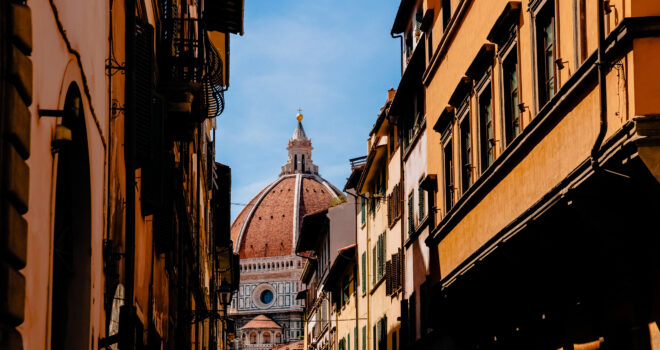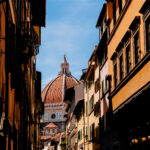It was common in the Victorian era for well-to-do middle and upper-class families to send their youths abroad towards the end of schooling—probably around what we would call 11th or 12th grade—and this was one of the key elements of “finishing” an education. The literary trope in fairy tales of “going to seek your fortune” is perhaps connected to the medieval practice of apprenticeship away from home, where a young man went from his hometown to another household to learn a trade, manners, and the responsibility of adulthood.
Going abroad to enlarge one’s mind and round out an education remains important today, regardless of your age or education. “Study-abroad” college programs, foreign exchange students, and pilgrimage tours bear witness to some recognition of this. But what exactly are travel’s benefits? And how can it avoid degenerating into tourism?
Catholicism of Europe
Hilaire Belloc, in The Cruise of the Nona, writes of his contemporary Englishmen as ignorant of the “fact” of Catholicism because they did not travel to mainland Catholic Europe. Modernism and Catholicism were the two ultimate forces facing each other, Belloc thought, and the idea of Catholicism as an inconsequential and spent force was due to ignorance of the world at large:
If those who make the objection I have just recited would use travel wisely, or even read contemporary Catholic writing in their own country, they would appreciate that what I have said is true if one regards Western Europe as a whole. Outside England every one is aware of the Catholic Church; two great armies face each other, and the issue is doubtful. All instructed Europe sees a great duel set between the Catholic Church and its opponent. All instructed Europe sees that this duel is taking the form of anti-Catholic laws and of proposals of laws upon the one side, and upon the other of growing Catholic social power.
One beautiful experience I remember having as a teenager was attending the Latin Mass in Paris: amid all the cultural differences of that city, the Mass could still be the same.
Another realization traveling can bring home with regard to Catholicism is the destruction that has been wrought in the Church since Vatican II. In America, it is easy to go for months or years on end without ever seeing a church built before the 1970s. This numbs the total effect of the knowing that there was a Pre-Vatican II Church. Henry Sire, in Phoenix From the Ashes, writes that “the atrocities inflicted on the Christian heritage are known to everyone who has traveled to see the great works of Christian art; they include the horrendous modernization of Notre Dame and the criminal desecration of Fischer von Erlach’s University Church in Salzburg.”
If you stand outside a towering Gothic Cathedral, drinking in the overpowering awe of its majesty, the disjunct and feeling of desecration when you enter and see a modern table where a matching high altar ought to be will drive home your head-knowledge of the destructiveness of liturgical reforms. I recently wrote of such an experience in Paris, where the grandeur of an ancient church was disturbingly juxtaposed with a bare, contracepted, and modern Blessed Sacrament chapel.
More Than America
We Americans sometimes seem to assume that most of the world is like America or at least wishes it could be American. As James Kalb has pointed out in his new book The Decomposition of Man, one of the major reasons for “foreign policy failures in the Middle East and Afghanistan has been the stubbornly held view that the people there are just like Americans.” That is, happily, not the case—and it is often a surprise to someone who has never left the USA.
Even conservative and traditional Catholics, I think, have a subconscious Americanist tendency to assume that “the progressive West is the transparently correct standard to which everything aspires,” to use Kalb’s phrase. The simple realization that there are other ways of making and enjoying food, designing toilets, and crafting daily schedules besides the standard created by middle-class white Americans is a healthy opportunity for open mindedness. Travel, then, is an important antidote for Cultural Cabin Fever, as long as one travels with a willingness not to impose one’s preconceived notions on the foreign people and places one experiences.
Even those who are, technically, highly educated are “provincial”, in the words of Belloc. “They should appreciate the modern world more exactly. They could arrive at such an appreciation by a wise use of travel, and of even their own contemporary society; by getting to know many kinds of men intimately in France, Italy, Germany, Spain, and Belgium, and by reading the words written upon the Catholic side—a thing which, for the most part, they wholly neglect to do.” Which leads me to my next point: a truly transformative experience needs time, not tourism.
Slow Down
Fr. Luigi Giussani, the founder of the Communion and Liberation movement, writes in his book The Religious Experience of the importance of not imposing a preconceived notion of reality on our experience such that a true perception of facts is inhibited by forcing them into a “scheme already in our minds”: it is a “pressing necessity not to accord a more important role to a scheme already in our minds, but rather to cultivate the entire, passionate, insistent ability to observe the real event, the fact.” This is not to say that preconceived structures of thought and belief are a bad thing or to be avoided (or even could be avoided); but simply that they ought not to be accorded so much importance that they prevent us from knowing a reality which might not fit into our current understanding or schema.
This slowing down and holding at arm’s length of presuppositions is very important for truly educational traveling. Tourism moves quickly and shallowly from one famous attraction to the next, without stopping to allow the fact to register. You see the Mona Lisa, snap a picture, and say “Wow, that’s beautiful,” and move on. Did you really see the Mona Lisa? Did you really experience it as beautiful or just have the automatic reaction you knew you were supposed to have? Were you open enough to the fact of the painting that you could have the experience of saying “Hmm. This is an overrated piece of art” (which is my general feeling).
The glazed eyes and clicking cell-phones of most tourists even in holy places like Saint Peter’s, the Basilica of St Francis in Assisi, or Saint-Chapelle in Paris, bear witness to the fact that as moderns we do not often approach the foreign as something to be truly discovered. Instead, we conform ourselves to the clichéd reaction, “the done thing,” and rarely have a genuine experience.
When making travel plans, I would always recommend staying longer in fewer places than moving quickly from one major attraction to another. If you have two weeks in Europe, don’t try to visit Assisi, Florence, Rome, Paris, and London. Just try one week in Paris, and one week in Florence, for example. That way you will have time to discover things at a human pace. You will visit the same cafe five times instead of once; notice the same old man there every day; try each of the different gelato flavors. You will see the towers of Notre Dame in the morning, noon, and evening, and decide you like another church better—one that nobody has ever heard of.
Take note, then, of the importance of traveling. My personal opinion is that a several week trip to Europe is a nearly incomparable educational gift to a maturing high-schooler. Old enough to appreciate art and boar sausage without saying “when are we going home,” with enough stamina and interest for museums, the fifteen- or sixteen-year-old young lady or gentleman is still young enough for this experience to shape their early adult understanding of Catholicism, America, and the world. Don’t go with preconceptions; their overcoming is the point. Instead, allow for freedom of exploration, leisure to return to the same monument many times, and time to just sit on the steps of a fountain, writing or sketching. Traveling in Europe as a teenager, I remember one of the things that struck me were the roads and streets: cobbled, winding, uneven, utterly un-American streets. But one doesn’t go to Europe to see funny side-streets! Or do you?












